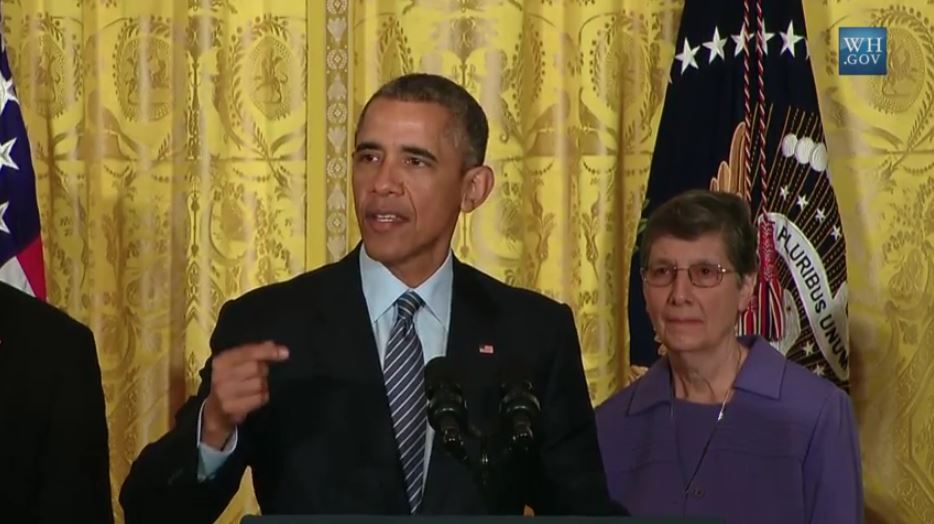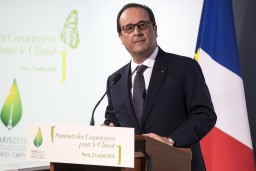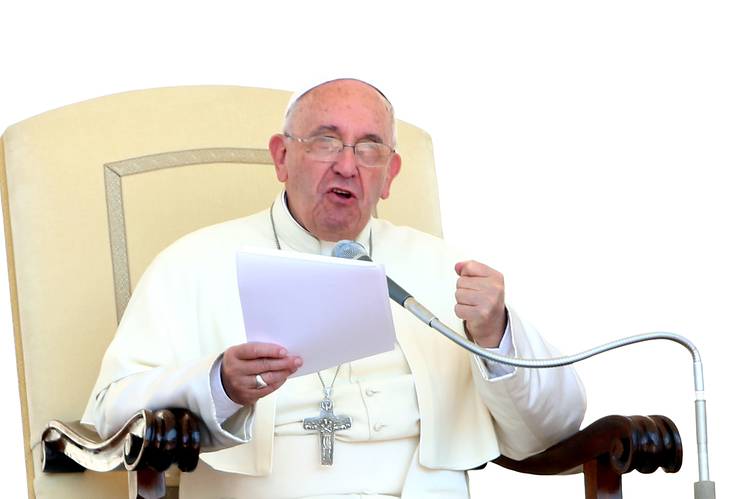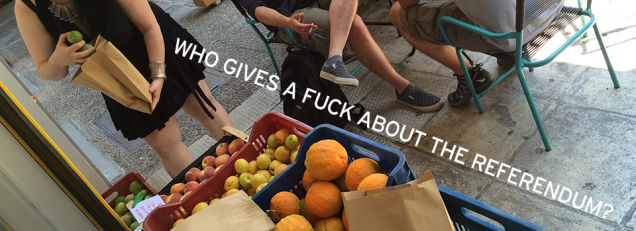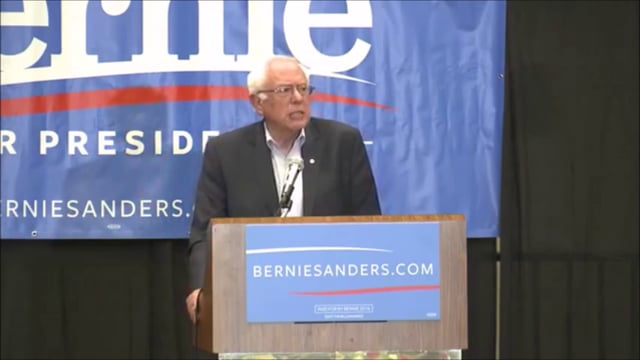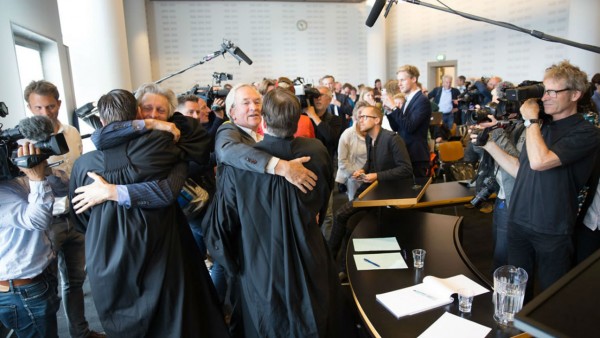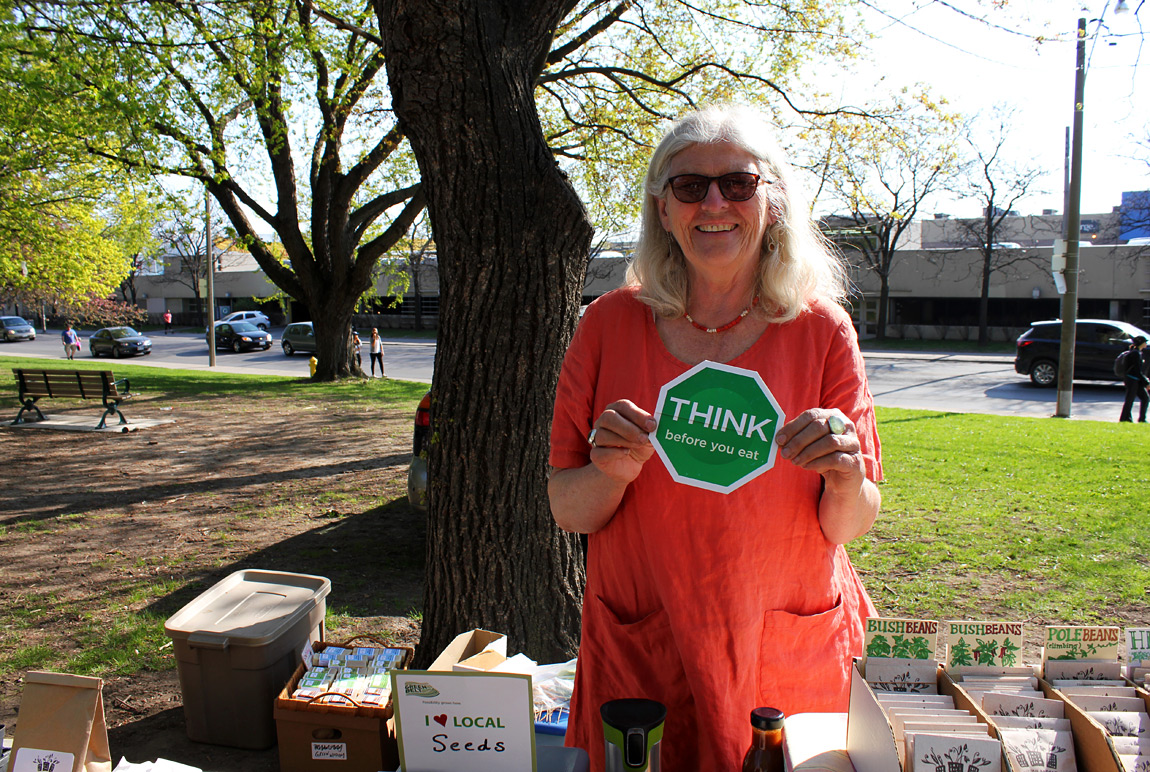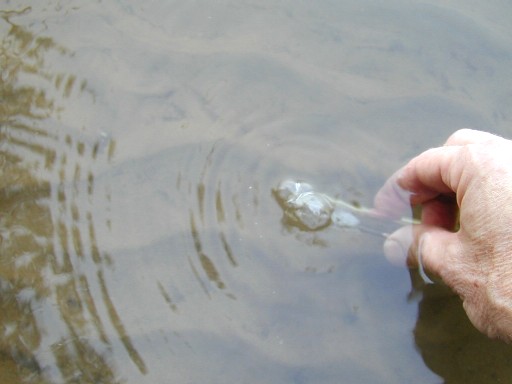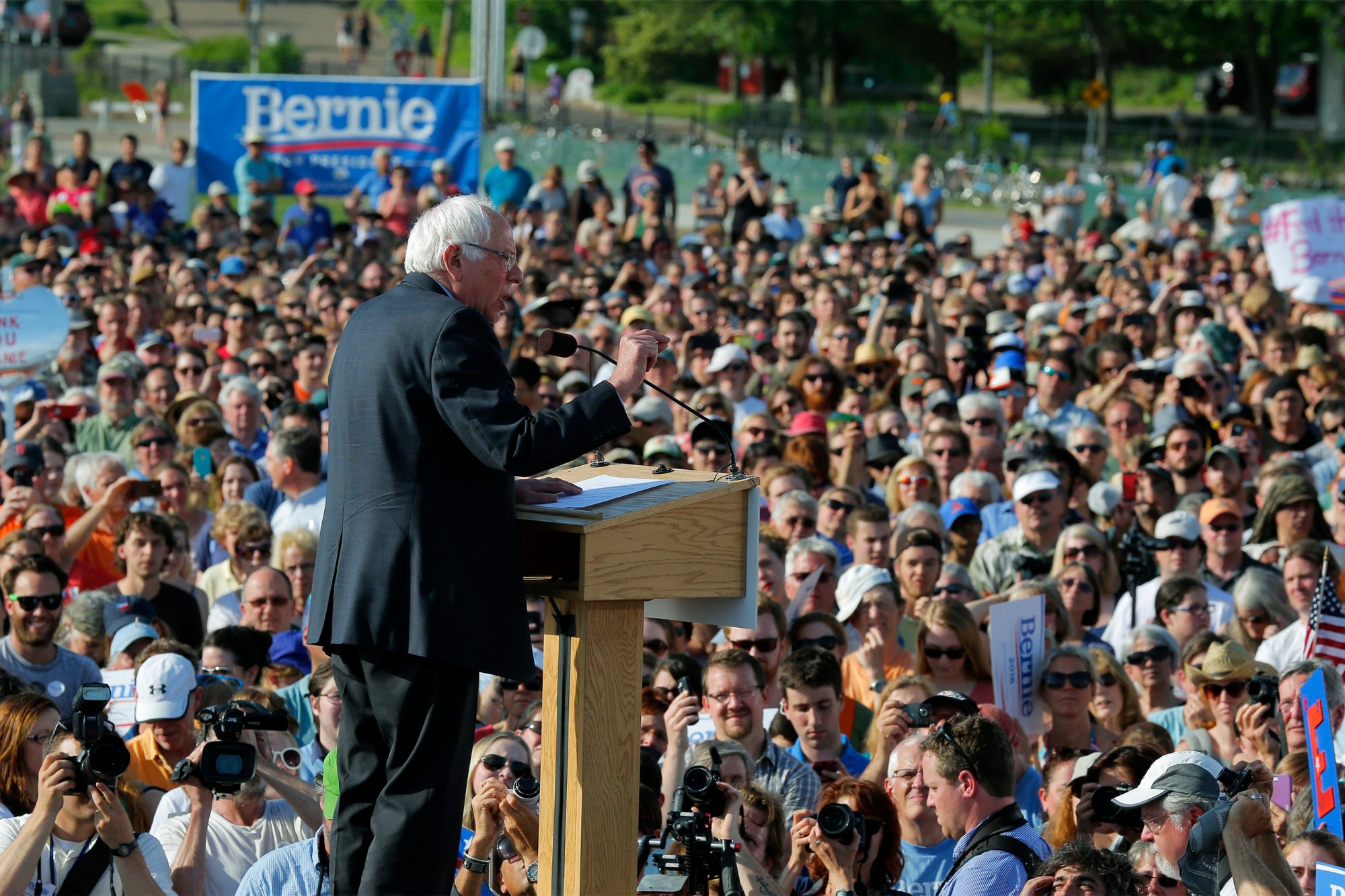Obama Reveals His Most Ambitious Plan To Tackle Climate Change
by
CREDIT: White House video screenshot
The Environmental Protection Agency released its long-awaited final rule to regulate carbon pollution from existing power plants on Monday afternoon. This is the most significant action any American president has ever taken to rein in climate change.
Addressing a crowd of scientists in the East Room of the White House, President Obama ticked through a list of threats that confronted the world since he took office: economic calamity, terrorism, nuclear weapons.
“But I am convinced that no challenge poses a greater threat to our future and future generations than a changing climate,” he said. “I believe there is such a thing as being too late. That shouldn’t make us hopeless. It’s not as if there’s nothing we can do about it. We can take action.”
Existing power plants will no longer be able to pollute unlimited amounts of carbon dioxide into the air in the United States once the plan takes effect, which will be 60 days following the as-yet determined date the plan is published in the Federal Register.
The coal, oil, and gas burned in most of these plants is responsible for nearly 40 percent of all carbon pollution in the United States. The Clean Power Plan sets the first-ever federal limits on the main pollutant that causes climate change.
“We now have a real shot of protecting this beautiful planet of ours,” EPA Administrator Gina McCarthy said before she introduced President Obama at Monday’s event. McCarthy summed up her agency’s approach in this video from the EPA:
The final rule’s national emissions targets were what had been expected. “Nationwide, by 2030, this final CAA section 111(d) existing source rule will achieve CO2 emission reductions from the utility power sector of approximately 32 percent from CO2 emission levels in 2005,” the rule stated. These reductions will result in $25-45 billion in net climate and health benefits by 2030, according to the agency’s analysis.
Obama also explained the plan at Monday’s event: each state will be able to come up with its own plan to cut emissions in a way that works for them. By 2030, each state must meet a certain emissions reduction target, custom-tailored to their current energy mix. The EPA does not implement a top-down solution across the country to cut emissions, or force specific coal plants to close.
“We’ll reward states that take actions sooner, rather than later, because time is not on our side,” Obama said.
Every state can meet its targets however it wants – closing old coal plants, building more renewable generation, increasing energy efficiency, or working with other states to balance emissions and cuts through market-based systems like the cap-and-trade model already being used by the RGGI states in the Northeast.
Since many states are already regulating carbon pollution, the president said that this federal action was just Washington catching up to that leadership demonstrated by the rest of the country.
Compared to the proposed rule, the new final version cuts more carbon pollution from the power sector, does it with more renewable energy and less natural gas, while providing more flexibility along the way to states trying to meet their targets.
The solar and energy efficiency industries lauded the rule. The wind power industry said it’s up to the task to help states comply.
“American wind power can do this,” Tom Kiernan, CEO of the American Wind Energy Association, said in a statement. “Low-cost wind energy reduced carbon emissions by five percent in 2014, and we’re capable of doing a lot more.”
Obama ticked through several of the criticisms the plan had received, including on electricity rates, coal jobs, and government overreach. He received a standing ovation for this passage about the plan’s impact on minority and low-income communities:
Even more cynical, we’ve got critics of this plan who are actually claiming that this will harm minority and low-income communities. Even though climate change hurts those Americans the most, who are the most vulnerable. Today, an African American child is more than twice as likely to be hospitalized from asthma. A Latino child is 40 percent more likely to die from asthma. So if you care about low income and minority communities, start protecting the air that they breathe and stop trying to rob them of their health care.
Carbon dioxide released from power plants traps heat and pollutants in the air, and so air quality diminishes. This helps to trigger asthma and heart attacks. The EPA says up to 90,000 asthma attacks will be avoided each year under the rule.
Later, the president went off script, saying “sometimes we feel as if there’s nothing we can do.”
“Tomorrow’s my birthday,” he said, and began to reflect on his younger college days. He said he arrived in Los Angeles in 1979 for college and wanted to go outside and take a run. But after five minutes, he couldn’t breathe, because of the horrible smog problem it faced. He listed other environmental calamities, such as Ohio’s Cuyahoga River being so polluted that it caught on fire.
Even with those horrible problems, he said, the nation came together to fix them. California’s air is much cleaner, as are Ohio’s waterways. The parallel to climate change was clear.
“We can figure this stuff out as long as we’re not lazy about it,” he said.
These rules are not the result of new congressional legislation. They are the result of what the Clean Air Act tells the executive branch it has to do.
When Congress passed, and President George H.W. Bush signed, the 1990 update to the Clean Air Act, it included a section on pollutants not specified or envisioned by lawmakers at the time. In 2007, the Supreme Court decided in Mass. v. EPA that carbon dioxide qualified as a pollutant that could be regulated under that section of the Clean Air Act if the EPA found it to be a danger to public health. In 2009, the EPA found exactly that, and so the Obama administration began regulating sources of carbon dioxide. It started with mobile sources of carbon pollution, and so the administration set greenhouse gas emission standards for cars, trucks, and heavy-duty vehicles. The Clean Power Plan is just the next step in regulating carbon pollution as required by the Clean Air Act. Monday’s announcement will set the EPA, working with the states, to regulating power plant carbon pollution.
The EPA also released its final rule for new, modified, and reconstructed power plants. Unlike the rule for existing plants, this rule sets a specific limit on coal-fired plants: 1,400 pounds of CO2 per megawatt‐hour, which is less-stringent than the proposed rule’s standard of 1,100 pounds of CO2 per megawatt‐hour. This change was made, after feedback the EPA received about the cost of implementing a carbon capture and sequestration system.
“I don’t want to fool you, this will be hard,” the president said in his Monday speech. “We’re the first generation to feel the impact of climate change, we’re the last generation that can do something about it. We only get one home. We only get one planet. There’s no Plan B.”
As the speech concluded, Obama got emotional, his voice softening. “I don’t want my grandkids not to be able to swim in Hawaii or not to be able to climb a mountain and see a glacier because we didn’t do something about it. I don’t want millions of people’s lives disrupted and this world more dangerous because we didn’t so something about it. That’d be shameful of us.”
“This is our moment to get this right and leave something better for our kids,” he said. “Let’s make the most of this opportunity.”
The event was supposed to be held outside on the White House South Lawn, but was moved inside due to high heat and humidity. Monday was the 11th straight day that cracked 90 in Washington, D.C.
Host Country Of Upcoming Climate Summit Passes Energy And Climate Overhaul
On Wednesday, France, host to the major United Nations conference on climate change at the end of the year, passed a law that both re-envisions the country’s energy system and sets an impressive precedent for the leadership potential France could offer come December.
The long-anticipated law will halve the country’s energy consumption by 2050, cut nuclear power production by a third by 2025 (from 75 percent of electricity mix to 50 percent), and increase renewable energy to 32 percent of total energy consumption by 2030. It also requires France to reduce carbon emissions by 40 percent by 2030 compared with 1990 levels, in part by reducing fossil fuel consumption by 30 percent in 2030 compared with 2012. The emissions reduction requirement is in line with the E.U.’s 28-country commitment to cut emissions at least 40 percent by 2030.
That’s a lot to keep track of. As part of the effort, the French parliament will have to produce “carbon budgets” every five years, which will help set emissions targets for different parts of the economy. Large emitters will face a more stringent carbon tax that could nearly quadruple by 2020 from its current rate of 14.50 euros ($15.93) per metric ton.
France introduced its domestic carbon tax in 2014 to cover companies not regulated by the E.U. Emissions Trading Scheme (ETS), including those consuming natural gas, heating oil, and coal. The tax later expanded to fuels including gasoline and diesel. Originally, it started at 7 ($7.69) euros/metric ton.
As the Carbon Pulse reports, “only around five percent of France’s power comes from fossil fuels, so the tax increase will have little bearing on electricity prices. However, the country relies on natural gas and fuel oil for much of its domestic heating, meaning the higher tax will raise some household bills while adding an estimated 7 cents to a litre of gasoline and 9 cents to a litre of diesel by 2022.”
While the fossil fuel, greenhouse gas emissions, and renewable energy targets likely stand out to the international community, the rapid curtailment of nuclear power is probably the most substantial, and controversial, domestic element of the law. France is the second biggest nuclear energy producer in the world, and the country that relies most on it for electricity, with 58 reactors at 19 different power stations. In his 2012 campaign, French President Francois Hollande promised to cut back the country’s reliance on nuclear power. The new law effectively means that some of the older nuclear plants will close in the next couple years to meet the 63.2 gigawatts production limit to be put in place.
The exact manner in which these cuts will be implemented is yet to be fully agreed upon, which had led to some pushback from environmental groups like Greenpeace.
“This law sets goals, which is interesting, but it doesn’t explain how to reach them,” Greenpeace energy campaigner Yannick Rousselet told Reuters.
While the reduction in nuclear power will also cost some jobs – the industry employs an estimated 220,000 people – French Environment Minister Segolene Royal said the reforms will create 100,000 new jobs in the green sector in the next three years.
“It’s the most advanced law of its kind among industrial countries,” Royal said in an interview with French media.
President Hollande has even bigger achievements on his mind when it comes to climate change. On Tuesday at the “Summit of Conscience for the Climate” in Paris, Hollande said “an agreement must be found” at the Paris U.N. climate summit in order to avert climate crisis.
“Today, with the agreement we see taking shape, we are still above two degrees Celsius, and probably three,” said Hollande. A viable deal needs to forsake “the use of 80 percent of fossil-based energy resources to which we still have easy access,” according to Hollande.
Across the channel on Wednesday, the British government made a controversial move in seemingly the opposite direction of France by announcing plans to curb subsidies for renewable forms of energy like small solar projects and biomass generators. The plan comes weeks after the newly re-elected Liberal Prime Minister David Cameron’s government said it would also discontinue onshore wind farm subsidies next year.
“We can’t have a situation where industry has a blank cheque and that cheque is paid for by people’s bills,” said energy secretary Amber Rudd.
In responding to the cuts, the U.K.-based Guardian newspaper stated in an editorial that “it is true that some of the incentives have been too successful,” but that “just like fracking and nuclear, greening the energy supply needs intervention. It will not be cheap. But for future generations, not doing it will cost far more.”
Mutant Flowers From Japan’s Fukushima Nuclear Disaster Go Viral Online
Four years after the disaster at Japan’s Fukushima nuclear power plant, strange things still are happening to the plants and animals living there.
Recent years have brought reports of deformed fruit and mutant butterflies, but the latest is a remarkable photo of deformed daisies posted on Twitter by @san_kaido, who took the photo below in Nasushiobara City, which lies about 70 miles from Fukushima.
Translated from Japanese, @san_kaiod’s tweet describes how the daisies growing there have apparently been impacted by exposure to radiation since the March 2011 incident, which resulted in the meltdown of three of Fukushima’s six reactors following a devastating tsunami:
“The right one grew up, split into 2 stems to have 2 flowers connected each other, having 4 stems of flower tied beltlike,” according to Fukushima Diary. “The left one has 4 stems grew up to be tied to each other and it had the ring-shaped flower. The atmospheric dose is 0.5 μSv/h at 1m above the ground.”
マーガレットの帯化(那須塩原市5/26)②
右は4つの花茎が帯状に繋がったまま成長し,途中で2つに別れて2つの花がつながって咲いた。左は4つの花茎がそのまま成長して繋がって花が咲き輪の様になった。空間線量0.5μSv地点(地上高1m) pic.twitter.com/MinxdFgXBC
— 三悔堂 (@san_kaido) May 27, 2015
The last sentence from the tweet — about the radiation dose now being “0.5 μSv/h at 1m above the ground” — describes the radiation dose per hour that’s now present at the site where the photo above was taken. It’s classified as safe for “medium to long term habitation” according to this explanation of radiation levels.
That no doubt played a part in the Japanese government’s recent decision to allow more than 7,000 residents of a town near the Fukushima plant to return home, four years after being evacuated. As the London Telegraph learned, however, it’s unclear how many residents actually will go back to live there permanently.
“There are no shops. There are no doctors. I don’t know what to do,” one former resident told local Japanese media.
Bliive: Brazilian barter website turns time into money
Maritza Reboucas is working late in her apartment in Sao Paulo’s Jardim Santa Ines neighbourhood.
She is teaching breathing techniques via Skype to someone she met online a few minutes ago.
A sales person during the day, Maritza moonlights as a breathing coach, helping people with health issues such as anxiety and stress.
She has had professional yoga training and could be charging about £30 per session. It would probably not be hard to find customers.
But Maritza is not receiving any Brazilian reais, dollars or pounds. Instead, she is being paid in a virtual currency called Time Money.
Sharing economy
She is one of almost 100,000 users of Bliive – a Brazil-based website that brands itself as the world’s largest online time-exchange platform.
Bliive looks and feels like a social media platform. Its users trade services, including guitar lessons, air conditioner repairs and tarot card readings, without any cash or credit card transactions.
For each hour of service provided, the user receives Time Money, with which they can buy another service.
Maritza earned almost 40 hours’ worth of Bliive services. With that much Time Money, she was able to create her own website about breathing techniques, including her own branding.
“I am told that paying someone to do your own website is not cheap,” she says.
“But I was able to do it all by finding on Bliive others who would help me.”
Each person offers their help in one-hour chunks, and people who have “exchanged” Time Money can rate and review the quality of the service provided.
Top young innovator
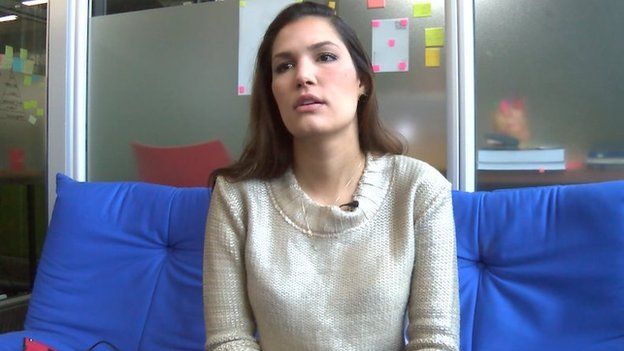
Bliive was founded a year and a half ago by Lorrana Scarpioni, 24, a public relations student.
She now employs a team of about a dozen people in Sao Paulo.
She came up with the idea after watching documentaries about the sharing economy and alternative currencies.
If people were willing to engage in couch surfing – letting complete strangers into their houses – surely there was a potential for exchanging something as simple as one hour of a service, she says.
“Bliive is a collaborative network of time exchange,” Lorrana adds.
“We see this platform as a movement that shows people the real value of exchanges and how they can develop themselves this way.”
Tax free
Bliive takes the concept of the sharing economy – popularised by platforms including Uber and Airbnb – a step further.
It creates a new channel between the supply and demand of services, and does away with conventional cash altogether.
More than 90,000 services are on offer on the website, making it larger than other barter-based sites, including Swapaskill.com, BabySitter Exchange and ChoreSwap.
It is hard to estimate how much Time Money that would be worth, as Bliive’s services vary in nature and value.
But using Maritza’s example – £30 per hour – would imply that it has helped exchange more than £2m worth of services.
All of that has occurred in a legally tax-free manner, as authorities cannot tax the barter economy.
Going corporate
Users such as Maritza have been able to create Time Money for themselves out of thin air. But making money for Bliive’s owners is proving more difficult.
Not all sharing economy start-ups are as lucrative as Uber or Airbnb – worth billions today.
Bliive does not sell advertising, and the service is completely free for regular users.
Most of the start-up’s funds have instead come from investors attracted by its potential.
“If I was an investor in the company today, I wouldn’t be most concerned about the lack of a clear financial model,” said Lisa Gansky, author of The Mesh: Why the Future of Business is Sharing.
“At the moment, exchanges are happening and inventory is growing, and we have seen with so many digital platforms that once there is a substantial community and/or assets in the network, there are many ways to extract value.
“LinkedIn is a very good example of this, as they provide a free service to individuals and found a way to charge professionals for a premium service.
“I wouldn’t be worried right now about how to capture value, only how to create and extend it.”
Lorrana is, however, trying to make some money by launching a paid service for corporate clients.
Companies can pay about £3 per month per worker, so that their employees exchange professional or personal services – such as training – via Bliive.
One of the start-up’s first clients is a call centre with 35,000 employees.
“Sometimes companies bring people from outside to teach things like how to speak in public. But you might have a very talented guy sitting just two tables away from you in the same firm,” she explains.
“We can connect the firm with its own talent.”
Unemployed youth
The business also recently opened an office in London, with help from the UK’s Sirius programme for innovative global ideas.
Lorrana sees potential in European markets, where more users are accustomed to the sharing economy – one survey suggests more than 30% of people in Britain have used one such service already.
She also sees opportunities in markets including Greece and Spain, where youth unemployment is high and people lack euros to pay for services.
“The no-money-involved transferences can be a great alternative to keep people developing themselves. We see a lot of people who have graduated with very nice degrees, but they don’t have jobs,” she says.
While Bliive aims to become more profitable, Lorrana is keen to retain its core values.
“We use these talents and values to create a world that is more collaborative and less competitive – more focused on the value of people, not just the value of money,” she says.
Is Going Vegan the Solution to Climate Change?
Becoming a vegan has been hailed as the solution to so many of the planet’s woes. Heck, even Jon Stewart said it. Gene Baur of Farm Sanctuary went on The Daily Show a few months ago and told Stewart:
We could save 70 percent on health care costs if we switched to a whole foods, plant-based diet in this country, we could save so much on resources-water, for example, half of the water used in this country is used to raise animals for food-and animal agriculture contributes more to climate change than the entire transportation industry.
So, do we all need to become vegans in order to stop climate change?
This video from The Guardian offers some insightful answers. Watch here:
Sanders Calls Out Clinton’s Silence on Keystone XL
Presidential candidate Hillary Clinton met behind closed doors with House and Senate Democrats Tuesday to talk about her positions on key issues. According to the members of Congress who attended the lunch, she told them that climate change can be a winning issue for Democrats, especially among younger voters, if they can develop a message to persuade voters that action is essential.
“She was incredible,” said Maryland Sen. Ben Cardin. “She really relates [climate change] to the current political communities and how we have to do a better job. We know the policy, but we have to do a better job on the politics.”
Congressman Raul Grijalva of Arizona, who co-chairs the House Progressive Caucus, also gave Clinton’s session a favorable review.
“I thought it was pretty solid,” he said. “Some of the progressive issues and members have kind of been crying in the wilderness for a while, and now these issues like climate change, income inequality and the jobs agenda are resonating with the public. The fact that the progressive causes and organizations feel more in touch with and included with Hillary now is a mark that she understands that.”
“You hear issues from her when she’s out on the stump that are pretty much identical with what progressives are saying in the caucus,” said Ohio Sen. Sherrod Brown.
According to the National Journal, “Clinton framed global warming as a pressing and serious threat and touted the climate credentials of John Podesta, the chairman of her 2016 campaign and a former climate adviser to President Obama.”
However, she also went easy on coal, according to Sen. Joe Manchin, who represents the coal mining state of West Virginia. He invited Clinton to tour West Virginia’s coal country.
“She was very much concerned,” he said. “She said people need to realize what coal has done for this country. People don’t realize that; they just want to condemn it now, and she was very compassionate about that.”
In addition, Clinton continued her silence on an issue that many environmental activists see as make-or-break: the Keystone XL pipeline. She has said nothing about whether she would give the project a thumbs-up or a thumbs-down.
One of her competitors for the Democratic presidential nomination, Vermont Sen. Bernie Sanders, left the meeting early and held a press conference to remind reporters that he is more progressive than Clinton and that he stands firmly against the pipeline.
“I have helped lead the opposition against the Keystone pipeline,” said Sanders. “I don’t believe we should be excavating or transporting some of the dirtiest fuel on this planet. I think Secretary Clinton has not been clear on her views on that issue.”
Senate Minority Leader Harry Reid said that Sanders has also been invited to come make a presentation to congressional Democrats.
A third Democratic primary candidate, Martin O’Malley, has also been running on strong environmental advocacy and opposes Keystone XL. He has called for the U.S. to be powered 100 percent by renewables by 2050. Both O’Malley and Sanders joined Green Party candidate Jill Stein in taking a pledge -promoted by The Nation and 350 Action-to reject any campaign funding from fossil fuel companies. Clinton did not respond to the pledge.
But regardless of where Clinton stands in relation to Sanders and O’Malley, her record and her remarks on climate are in stark contrast to the entire Republican field, now up to 15 candidates and soon to be 16 when Ohio Gov. John Kasich announces his candidacy on July 21. While a few have tentatively said that climate change is likely happening, all have warmly embraced the fossil fuel industry and most have joined congressional Republicans in rejecting steps to address climate, and all support the Keystone XL pipeline.
Pope Francis warns against “new forms of colonialism”
Pope Francis once against spoke to a gathering of representatives of worldwide popular movements. He last met with them in Rome this past October, when they discussed social problems like unemployment and a lack of housing and land.
On this occasion, the Pope came to them. He delivered the most powerful and wide-ranging speech of his trip.
“Human beings and nature must not be at the service of money. Let us say no to an economy of exclusion and inequality, where money rules, rather than service. That economy kills. That economy excludes. That economy destroys Mother Earth.”
He denounced “new forms of colonialism” that leave entire groups of people as nothing but suppliers, impeding their ability to grow and develop.
“The new colonialism takes on different faces. At times it appears as the anonymous influence of mammon: corporations, loan agencies, certain ‘free trade’ treaties, and the imposition of measures of ‘austerity’ which always tighten the belt of workers and the poor.”
The Pope said that new and old forms of colonialism must be abandoned.
He did not overlook “offenses” committed by the Church during his condemnation of colonialism. The Pope apologized for crimes committed against local populations during the conquest of America.
“I wish to be quite clear, as was Saint John Paul II: I humbly ask forgiveness, not only for the offenses of the Church herself, but also for crimes committed against the native peoples during the so-called conquest of America.”
At the same time, Pope Francis said that it would be unfair to ignore the Christians who also left behind “works of human promotion and love” among Native populations. He also highlighted Latin America’s profound Christian identity.
The Pope mentioned that these things have happened in other parts of the world, as well. Even today, Christians are persecuted.
“This too needs to be denounced: in this third world war, waged peacemeal, which we are now experiencing, a form of genocide is taking place, and it must end.”
Pope Francis asked for the crowd to pray for him, but not everyone in attendance was Catholic. So he made a special request for those who do not believe.
…Think about me and send good vibes. Thank you.
What No One Is Talking About When They Talk About Greece

“You all have CSAs in the States, right? That’s amazing.”
I wasn’t entirely sure I fully understood what he was getting at. It was spring, 2012, and we were standing around at a squatted anarchist social center in a southern suburb of Athens, where I’d just given a talk on anarchism and Occupy Wall Street.
A few days earlier, in Syntagma Square opposite the Greek parliament building, a local retired man had shot himself in the middle of morning traffic. The note he left detailed his refusal to be a burden on his children as Greece’s economy spiraled, and called for young people to string up those responsible for its collapse. It made for a downright chilling read, even in translation.
“You mean, like…people buying shares in local farms?”
Back home in the U.S., Greek anarchists were celebrated for their perceived tenacity and bravado. Like giddy adolescents sharing pornography, left social media circulated YouTube clips of low-scale street warfare. (These days, the shared content is more likely to be various expressions of global panic over Greece’s potential exit from the euro.) It seemed unlikely that my companion wanted to talk to me about community-supported agriculture, the veggies-in-a-box default practice of the boring, NPR-member mainstream liberal. And yet, he did.
This was before the ascendancy of Syriza, and before Syriza’s prospects for negotiating some economic relief disappeared. A default on IMF debt repayments now seems inevitable, and an exit from the Euro seems more likely by the day. Much faith has been put in Syriza as a sort of leftist foil to late European austerity-not just in Greece, but throughout the world-and Syriza’s ambitions would have been crushed rather swiftly, were the party not willing to play the country’s exit from the continental currency (and the ripple effect that would have for financial markets the world over) like a poker chip. http://fortressamerica.gawker.com/how-the-lefts-…
While liberal and left-wing Americans stare distastefully and apprehensively at their pitiful… Read more Read more
All of this, of course, after months of domestic expectation-management from Syriza’s camp, paired with frequent slander of the very social movements on whose rhetoric the party rode to electoral victories-victories whose ends prove increasingly elusive.
But in Athens, right now, the saga appears to have resulted in a certain fatigue on the ground. Life goes on, looking much as it would’ve otherwise, beyond the occasional, small line at an ATM-or the dueling yes/no referendum rallies in Syntagma, both ends of that contrast as likely a response to relentless humiliation as they are anything else.
Monday night, as the “no” gathering in Syntagma swelled, residents in the Agia Pereskevi neighborhood gathered to discuss a scheduled day of events for this coming Sunday; events mostly for local children. These activities would coincide (however unintentionally) with the proposed referendum on the EU’s austerity proposal, and it seemed intuitive that a change of plans might be in order.
I casually browsed Twitter on my phone, watching the world collectively soil its pants over Greece’s situation, while a friend whispered translations of the discussion over my shoulder. At one point, one woman put a point to what was both the overriding sentiment, and a question well worth asking, given what’s unfolded in Greece for the better part of a decade, now: “Who gives a fuck about the referendum?”
In the wake of the 2008 uprising that swept the country following both the police shooting of a teenager in the central neighborhood of Exarchia and Greece’s economic free-fall, horizontal, community self-management became both a practice and a demand. Popular assemblies-like the one in Aghia Pereskevi-formed in roughly seventy neighborhoods throughout metropolitan Athens, some within occupied government buildings.
Earlier this year, The Guardian reported on how these structures are serving to “fill the gaps left by austerity.” A variety of what would’ve been called survival programs in the era of the Black Panther Party have been carried out through such assemblies across Athens: food and clothing distribution, supplementary education programs for children, basic health services, mental health support, eviction defense – all administered via face-to-face, direct democracy.
When a tax increase folded into electricity bills resulted in cutoffs for people unable to pay, lists were made and local electricians were dispatched to illegally restore services, with priority afforded to those most vulnerable (the elderly, new parents). A former military installation seized by residents and converted into a community park and cultural center boasted sizeable gardens, tended by locals of varying ages.
When I visited one of the city’s oldest popular assemblies in 2012, in the neighborhood of Petralona, residents had just opened a kitchen space on one street corner, with the intention of both providing affordable meals and educating young people about food cultivation, preparation, and health. Participation in all of it seemed pretty eclectic, to my outsider eye. Even local government officials joined in-acting as residents like any others, sometimes with their families in tow. Perhaps even more telling, assemblies were sharing resources between neighborhoods. They were confederating, demonstrating both an ability and an intention to scale up.
Taking all of this in, my anarchist acquaintance’s interest in community-supported agriculture that night in 2012 started to make sense. It makes even mores sense now. With the IMF and Troika twisting arms, threatening empty store shelves if its various austerity programs aren’t adopted, direct relations with local agricultural production offer a keenly radical possibility.
Channeling that possibility, a ten person collective opened a grocery and coffee bar on the edge of the central Athens neighborhood of Exarchia.
“There was a time when people didn’t have much of a relationship with the villages their families were from – specifically the land their families cultivated” a woman working in the collective explained to me (she asked to keep her name out of this piece; police and fascists are real threats in Greece). “With the crisis, you started seeing people opt to plant on land in their villages. [The grocery store] was a way of consolidating and making available what we were producing.”
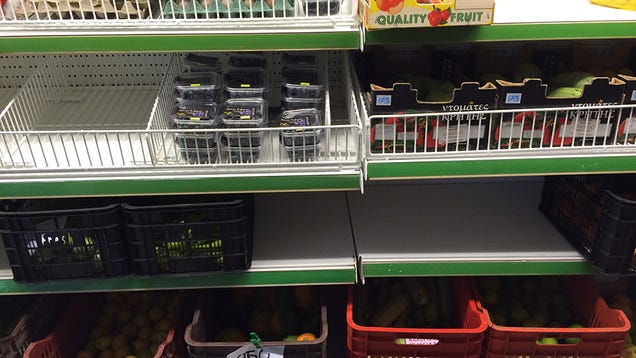
Financed by a loan from a network of worker self-managed businesses scattered throughout Exarchia (mostly cafes and restaurants), the project-organized democratically, on the same consensus model that drove the Occupy movement in the US-served a threefold purpose.
“The first objective was to support ourselves; those of us whose families were producing food items in their villages, as families, not using employees” the woman told me. Basic needs. Tomatoes. Flour. Olive oil.
“The second was to support people politically close to us, to create a workplace that could serve as a safety net and provide transitional work for people who’d lost jobs.” One such woman made my espresso freddo Monday morning. A graphic designer by trade, she’d been fired her first day back from the eight months of maternity leave to which Greeks are entitled-a warning to any other staff entertaining such audacity.
“The third was to provide food produced in ways consistent with our principles.” In the last decade, organic products saw something of a boom in Greece. “The primary focus was health, meanwhile these things were being produced by Pakastani immigrants with no job security, under horrible conditions. Some were killed. Our position was that a ‘healthy’ carrot produced in this way has no meaning, at all.”
The café represents an attempt to forge networked relationships-real sustenance-unfettered by faith in conventional politics, that gives instance to an altogether distinct vision for Greece. As a founding member of the Agia Pereskevi assembly told me over coffee this week, “This is what sets us apart from the traditional left – there is no doing for; we are the people whose lives are affected. And we’re taking on transformations that affect our lives.”
While these sometimes small projects, and much of what Greek popular assemblies have carried out could be viewed as triage out-scaled by the gaps left by austerity demands, that’s never been the view of participants I’ve spoken with. With real consistency, they’ve seen themselves engaged in something prefigurative; forging new ways of organizing social life – life that will continue with or without the euro. And they’ve done so with considerable ingenuity, commitment, and (most importantly) success.
Finding myself back in Athens as the world’s gaze is cast back in its direction, with the clock ticking on the future of high politics in Greece and its relationship with the rest of the world, it seems fitting to counter the pummeling global humiliation to which Greeks are being subjected with some of what’s been done right in Greece since the crisis (none of it by anyone whose name you’ve heard). Because if we’re being even remotely honest, what titillates us most about this unfolding drama is not the great uncertainty that hovers over Greece, but that it invites us to look into our own future.
Editor’s note: Due to concerns about violent retaliation, we edited this piece after publication to remove proper names of venues and cut or crop photographs that clearly identified people. Joshua Stephens is a writer in an open relationship with Brooklyn, NY. His work has appeared in AlterNet, Truthout, Waging Nonviolence, and Perspectives on Anarchist Theory. He is the author of The Dog Walker: An Anarchist’s Encounters with the Good, the Bad, and the Canine, forthcoming from Melville House.
Bill Gates To Invest Billions In Renewable Energy
The Supreme Court may have dealt a crushing blow this week to President Barack Obama’s efforts to curb climate change, but all is not lost.
Microsoft co-founder and billionaire philanthropist Bill Gates announced plans to spend up to $2 billion on innovative renewable technologies over the next five years. In an interview with the Financial Times ( paywall), Gates said he hopes to “bend the curve” through the cultivation of “breakthrough” technologies, doubling an already impressive billion-dollar investment. He has so far written checks to 15 green companies, he said, and has contributed venture capital funds to another 30.
In the interview, Gates calls for far greater funding for renewable research, saying investment “should be like the Manhattan Project and the Apollo Project in the sense that the government should put in a serious amount of R&D.” He pointed to the drawbacks of now-commonplace technologies like solar, which can only provide power during the day.
“There’s no battery technology that’s even close to allowing us to take all of our energy from renewables and be able to use battery storage in order to deal not only with the 24-hour cycle but also with long periods of time where it’s cloudy and you don’t have sun or you don’t have wind,” he said.
Despite the recent Supreme Court ruling that undercut the Environmental Protection Agency’s regulation of mercury and other toxic emissions from power plants, the U.S. has been making strides in the fight against climate change.
The Huffington Post’s Kate Sheppard notes the EPA is finishing up rules that would limit greenhouse gas emissions from new and existing power plants, which should be finalized in the coming weeks. And the president has come out swinging against the warming phenomenon, citing the hazards against American’s health and a risk to national security.
Renewable energy is expected to draw trillions in investment over the next quarter century, but the Bill and Melinda Gates Foundation has come under fire before for some aspects of its climate activism.
The Guardian notes the Gates Foundation has yet to announced any plans to divest its portfolio from fossil fuels, despite similar moves from the likes of the Rockefeller Brothers Fund and the government of Norway. The Gates Foundation has $1.4 billion invested in fossil fuel companies including BP, according to 2013 tax filings.
You can read Gates’ entire interview at the Financial Times.
Dutch court orders 25 per cent cut in emissions by 2020 to protect citizens
THE HAGUE, Netherlands — A Dutch court ordered the government Wednesday to slash greenhouse gas emissions to help fight global warming, a landmark ruling in a case brought by hundreds of concerned citizens that could pave the way for similar legal battles around the world.
Climate activists in a packed courtroom in The Hague erupted into cheers as Presiding Judge Hans Hofhuis told Dutch authorities to cut the country’s greenhouse gas emissions by at least 25 per cent by 2020 from benchmark 1990 levels.
The country currently is on track for a 17-per cent reduction and it is not clear how it can achieve the further cut.
Environmentalists hailed the ruling as a victory in efforts to push governments to take more action to tackle global warming against a backdrop of slow-moving international negotiations aimed at forging a global agreement.
“The verdict is a milestone in the history of climate legislation, because it is the first time that a government was ordered to raise its climate ambition by a court,” said Wendel Trio, Director of Climate Action Network Europe. “We hope this kind of legal action will be replicated in Europe and around the world.”
Greenpeace called the Dutch ruling “a game-changer in the fight against climate change.”
The Dutch case may have already helped spur environmentalists in other countries into legal action.
Activists say a similar case is coming in Belgium and in Norway, a coalition of non-government groups is working on a case challenging their government’s licensing of new oil blocks in the Arctic, saying it violates the constitutional obligation to protect the climate.
“This is a great victory. The judge said exactly what we wanted and had the courage and wisdom to say to the government ‘you have a duty of care toward your citizens,”‘ said Marjan Minnesma, the director of Urgenda, the non-government group that brought the civil case on behalf of some 900 Dutch citizens.
Minnesma said Urgenda is ready to share details of its case with activists in other countries, saving them time and money in preparing the legal arguments.
The ruling came in the same month that Pope Francis released a massive encyclical on the environment urging nations to quickly overhaul their economies to cut emissions and save the Earth. France will also host a key U.N. conference later this year in Paris where it’s hoped that a worldwide accord to fight global warming will be signed.
The Dutch plaintiffs argued — and the court agreed — that the government has a legal obligation to protect its people against looming dangers, including the effects of climate change on this low-lying country. Large swaths of the Netherlands are below sea level and vulnerable to rising sea levels blamed on global warming.
The Dutch government, which can appeal, said it was studying the ruling.
Environment Minister Wilma Mansveld said the government and Urgenda “share the same goal. We just hold different opinions regarding the manner in which to attain this goal.”
Mansveld said the Dutch are working toward European Union greenhouse targets — cutting emissions by at least 20 per cent by 2020, from 1990 levels.
“Preventing climate change is the most successful when as many countries as possible join forces,” Mansveld said.
But judges said they want more action from the minister.
“The state must do more to avert the imminent danger caused by climate change, also in view of its duty of care to protect and improve the living environment,” read a statement from the court.
To avoid the most dangerous impacts of climate change, which is caused by heat-trapping carbon dioxide being released by burning fossil fuels, countries around the world have agreed that global temperatures should stay below a 2 degrees Celsius (3.6 F) rise compared to pre-industrial times.

A U.N. climate science panel has stated that to have a two-thirds chance of staying below that mark the world must cut emissions by some 40 to 70 per cent by 2050.
While the Netherlands is known as a land of windmills, it is also a country with vast natural gas reserves that are used to power millions of households. It lags behind many of its European neighbours in the amount of energy it consumes from clean, renewable sources like wind or solar power.
According to the EU statistics agency Eurostat, only 4.5 per cent of Dutch energy consumption came from renewables in 2013, compared to an EU average of 15 per cent. Sweden led the way with just over 52 per cent.
Renewable energy accounted for about 10 per cent of total U.S. energy consumption in 2014, according to the country’s Energy Information Agency.
The Dutch court said it was difficult to judge the economic impact of its ruling on Dutch companies but said “climate policy can have a negative effect for one sector, but a positive effect for another.”
Dutch business organization VNO-NCW did not immediately respond to requests for comment about the ruling’s possible effects on its members.
Bill Hare, senior scientist at Climate Analytics, a non-profit organization based in Berlin, said the Dutch ruling’s impact could be massive.
“(This) has the potential to become a precedent whose effect will ultimately flow through to undermining the markets for coal, oil and gas,” he said.
Community Celebrations and Why We Need Them.
Unifier Festival, 2015 “Community celebrations are important ritual signifiers. They give us a sense of belonging, but can also serve as a site of inquiry. They can help answer significant questions about histories, communities, and self-identity. Community celebrations are an important socializing force not only for newcomers, but also for children. Through participation in community …
Urban farming: not just growing food but communities
WATCH ABOVE: Urban farms provide fresh food to local residents, farmers markets and restaurants, but they are also changing neighbourhoods and lives. Allison Vuchnich reports.
Urban agriculture is growing – fast. Many large scale urban farms strive to be a force for change in lower socioeconomic neighbourhoods where access to affordable, healthy food can be challenging. The farms also offer employment, education and community building.
“The scale of what we have created is significant, it’s huge,” Michael Ableman from Sole Food Farms, told Global News. “You can have a large scale, agriculture scale, enterprise in the city and have that work and function and provide employment and provide volumes of food to people. That’s our goal, the jobs and the production volumes of food are very important to us.”
READ MORE: Do you want to know what’s in your food? Canadians want more transparency
Ableman spoke to Global News at Sole Food’s one-acre urban orchard in Vancouver. Considered the largest in North America, the land used to be an abandoned lot. Sole Food operates four locations totalling close to 4.5 acres in Vancouver with a fifth site in the works.
WATCH: Michael Ableman talks about Sole Food Farms large scale urban agriculture projects in Vancouver and the potential to transform not just the landscape.
The orchard is in the Downtown Eastside, where many struggle with drug addiction, poverty and homelessness; the orchard with its pears, apples, quince, figs and persimmons creates a culinary contrast. The farm provides food to local residents and community kitchens, but it also supplies farmers markets and close to 30 restaurants.
“I don’t want people buying our food out of some sense of charity,” said Ableman, “I want them to buy our food because it’s the best quality food.”
Growing quality food is also very important at The Black Creek Community Farm, located in the Jane and Finch neighbourhood in Toronto – an area with a history of poverty, crime and high food insecurity where access to quality affordable food is difficult. The seven acre farm is nestled away, off a busy noisy street; inside it provides an oasis and limitless possibilities.
Internet allows local artist to sell upcycled clothing around the world
Perhaps just 15 years ago, before the explosion of social media and online marketplaces allowed small-scale entrepreneurs and artists to sell their niche products to scattered customers all over the world, Mallory Ottariano wouldn’t have been able to do business the way she does now.
Out of a small studio in her home, Ottariano creates unique, eco-conscious, handmade clothing like stretchy yoga headbands, funky dance pants, skirts, tops and “tribal steampunk warrior Goddess” utility belts from upcycled materials. She peruses local thrift stores and other places to find her fabric, then she stitches bits and pieces together to give them new life and artistic style under the name KIND Apparel.
From there, she relies on Etsy, a peer-to-peer e-commerce website focused on handmade or vintage items. She has a list of order receipts on her wall from places like Brooklyn, New York, San Luis Obispo, California and Winston-Salem, North Carolina. When the Internet was still in its infancy, Ottariano would have had to rely on a local market for her wares, but now anyone anywhere in the world who wants an orange “upcycled cowl neck patchwork hoodie gypsy tunic dress” can connect with her. Perhaps one or two people in Missoula would buy such a product if she opened a shop on Main Street, but since she’s connected to the global marketplace, customers in every corner of the world can find exactly what they’ve been searching for.
“The Internet is amazing,” she said. “It’s been really crazy. I started this as a hobby in Massachusetts. I would go to a couple craft fairs a year. The Internet allowed me to move across the country without changing my business whatsoever and have no real repercussions.”
***
The success of her online sales has allowed Ottariano to dive in to her passion head-on. She recently quit her day job and has committed to building her personal business full-time. She averages five individual – and two or three wholesale – orders of varying sizes online every week. It’s something that would be inconceivable without the Internet, but she still relies on a little bit of the good old-fashioned grapevine network to help her locally.
“I got started on Etsy selling my one-of-a-kind stuff and then I developed my own website and then I have stuff at stores around town, but mostly it’s just word-of-mouth,” she explained. “I usually get custom orders through Etsy and people tell me ‘I like this item that you made in the past, but could you make it in a different size or a different color?’ Like this top that I’m making now, a woman is going to a mermaid parade in New York City and she wants a sea-goddess costume. But most people contact me through Etsy. It’s kind of challenging. We send lots of photos and emails back and forth.”
Etsy has changed a lot over the years, but Ottariano described it as “awesome.”
“I started selling on there two and half years ago, but it’s just a marketplace for people who are doing handmade items, and there’s so many people doing so many different things and creating stuff there,” she said. “I would liken it to eBay and Amazon for artists. It’s a marketplace that is not curated, anybody can be a part of it. People just go there looking for interesting home décor, clothing and jewelry and very specified items. The Etsy wholesale is curated, and you have to apply for it. About a year ago I got accepted, and it’s open to qualified buyers.”
***
Ottariano said that more and more people are becoming conscious about where their clothing is made.
“That’s sort of why I started this whole endeavor is because it’s been a way of life for me ever since I was a kid,” she said. “I was brought up in a household where we grew a lot of our own food and made a lot of our own clothing and attention to where things come from and consumer needs was a very big part of my childhood. I’ve been making my own clothes since I was little and I always wanted to be an artist. I think that there’s more awareness being brought up now, especially because things like Etsy are becoming so popular. Like, Etsy just started selling stock on Wall Street. It’s crazy, it’s awesome that people are investing in handmade art. “
The Internet not only allows her to connect to customers, but it allows those customers to educate themselves.
“I think that as YouTube gets bigger and media gets bigger people are becoming aware of working conditions and that child labor happens when you buy a T-shirt from India or China,” she said. “There is definitely a revolution coming about for handmade clothing. It’s definitely more expensive, but I think people are starting to understand what goes into that cost. It’s a cost of community and a cost of sustainability and progress.”
Being self-sufficient is one of her main themes.
“One thing that runs throughout my stuff is every single thing is done by my hands and I’m really proud of that,” she said. “I think that’s something that sets me apart. My business cards, I print them in my house and I cut them by hand. My headband packing containers are upcycled cereal boxes and I use a hand-carved rubber stamp. I don’t send things to a place to get mass-produced.”
Giving up a steady paycheck isn’t for everyone, she said, but she encourages other artists to research ways to market their products.
“I would say that if it’s something that you enjoy doing, nothing’s really going to stand in your way,” she said. “It might seem impossible and it might seem like it’s not going to work out, but figure out if it’s something that speaks to you and if it’s your calling.”
75 Percent of Animal Species to be Wiped Out in ‘Sixth Mass Extinction’
Under the most conservative estimate possible, development, disappearing habitats and climate change will exterminate animal species within just three human lifetimes, a new study finds.
An elephant killed by poachers lies among the grass in Mozambique. The species is among those threatened with extinction in the next three human lifetimes, a new study finds.
From rhinos to tigers to elephants, three out of four “familiar” animal species – those commonly thought of and well understood by human beings – will be extinguished within three human lifetimes, a new study finds, confirming that Earth is in the midst of what’s become known as the “sixth mass extinction” driven by runaway development, shrinking animal habitats and climate change.
“Scientists never like to say anything for sure, but this is close as we’re ever going to get to saying, ‘We’re certain that this is a huge problem,'” says study coauthor Anthony Barnosky, a paleontologist at the University of California-Berkeley, calling the problem “quite dire.”
[ READ: Pope Francis Encyclical Calls on “All Humanity” to Halt Global Warming]
The hundreds of species eliminated in the past century alone would otherwise have lasted at least another 800 to 10,000 years, the study found. Coral reefs “are in danger of annihilation” as soon as 2070, Barnosky says, potentially erasing a quarter of the ocean’s species.
The last mass extinction occurred 66 million years ago with the end of the dinosaurs. This is the only one, however, where a single species is responsible for the destruction of all the others. And by eliminating biodiversity, it threatens to disrupt the pollination, water purification, food chain and other “ecosystem services” that humanity’s “beautiful, fascinating and culturally important living companions” provide, the study says – threatening human life itself.
“You can kind of think of it as guns and bullets,” Barnosky says. “The guns are different in each case, but the bullets that come out – changing climate, increased CO2 and other gases in the atmosphere, ocean acidification – those things that contribute to mass extinction are the things that we’re doing today.”
Previous studies had established the world is in the midst of a mass extinction, with animals disappearing at far faster rates than expected. The term even made the title of New Yorker writer Elizabeth Kolbert’s 2014 bestseller, “The Sixth Extinction.” There is no way to know just how many species there are on earth – roughly 1.3 million animals have been described since 1758. A study last September, however, found the number of wild animals had likely been halved in just the past 40 years.
[ ALSO: Why an “Inadequate” Climate Agreement Might Be OK – Or Not]
But this latest effort is by far the most conservative: a study aimed at debunking any possible rebuttal that its findings are “alarmist.”
Barnosky and his team, hailing from Florida and Mexico as well as California, doubled the pace that species were expected to go extinct without any human interference, then used the lowest possible estimate for the number of species that actually were disappearing.
The results, even as an underestimate, proved just as dire.
Since 1900, birds, mammals, reptiles, amphibians and fish died 72 times faster than “normal,” this most conservative estimate found. Whereas researchers might have expected nine veterbrates to go extinct, instead 468 were wiped from the Earth.
Industrialization was especially lethal, with extermination rapidly accelerating from 1800 on.
“The most iconic bird species historically are gone – the ivory-billed woodpecker, passenger pigeon, Carolina parakeet, great auk, imperial woodpecker,” says study coauthor Paul Ehrlich, professor and president of the Center for Conservation Biology at Stanford University. “But there are many others less-well known – the gorgeous orange-bellied and golden-shouldered parrots of Australia, many large raptors, and likely many penguins – as climate disruption takes hold.”
The study was released one day after Pope Francis issued the Vatican’s first-ever encyclical on the environment and climate change, a 184-page letter urging Catholics and “all humanity” to respect nature, rein-in development and address global warming. It also comes six months ahead of a U.N. climate summit in Paris, where President Barack Obama and other world leaders reportedly hope nearly 200 nations will agree to reduce their carbon emissions.
Francis emphasized the need for swift action, a theme echoed by the research team.
“It really is possible to fix these big problems if people put their minds to it,” Barnosky says. “We’re at a stage now where people are becoming aware of the problem, and as people become aware we can move the needle toward making progress.”
[ MORE: EPA Sets Stage to Limit Aircraft Emissions]
That includes switching from fossil fuels to renewable energy sources like wind and solar, producing food more efficiently and limiting population growth. But no matter what actions are taken, there will inevitably be a cost, experts say.
“We’re not only in the midst of a sixth major extinction, we’re moving further and further into it,” says Bruce Stein, senior director of climate adaptation and resilience at the National Wildlife Foundation. “It’s clear that we are going to lose a lot of things, but it’s also clear that we have the ability to ensure that many of our systems will be different but will continue to have ecological functionality and continue to support many of these species.”
G7 leaders agree to phase out fossil fuel use by end of century
The G7 leading industrial nations have agreed to cut greenhouse gases by phasing out the use of fossil fuels by the end of the century, the German chancellor, Angela Merkel, has announced, in a move hailed as historic by some environmental campaigners.
Related: G7 fossil fuel pledge is a diplomatic coup for Germany’s ‘climate chancellor’
On the final day of talks in a Bavarian castle, Merkel said the leaders had committed themselves to the need to “decarbonise the global economy in the course of this century”. They also agreed on a global target for limiting the rise in average global temperatures to a maximum of 2C over pre-industrial levels.
Environmental lobbyists described the announcement as a hopeful sign that plans for complete decarbonisation could be decided on in Paris climate talks later this year. But they criticised the fact that leaders had baulked at Merkel’s proposal that they should agree to immediate binding emission targets.
As host of the summit, which took place in the foothills of Germany’s largest mountain, the Zugspitze, Merkel said the leading industrialised countries were committed to raising $100bn (£65bn) in annual climate financing by 2020 from public and private sources.
In a 17-page communique issued after the summit at Schloss Elmau under the slogan “Think Ahead, Act Together”, the G7 leaders agreed to back the recommendations of the IPCC, the United Nations’ climate change panel, to reduce global greenhouse gas emissions at the upper end of a range of 40% to 70% by 2050, using 2010 as the baseline.
Merkel also announced that G7 governments had signed up to initiatives to work for an end to extreme poverty and hunger, reducing by 2030 the number of people living in hunger and malnutrition by 500 million, as well as improving the global response to epidemics in the light of the Ebola crisis.
Poverty campaigners reacted with cautious optimism to the news.
The participant countries – Germany, Britain, France, the US, Canada, Japan and Italy – would work on initiatives to combat disease and help countries around the world react to epidemics, including a fund within the World Bank dedicated to tackling health emergencies, Merkel announced at a press conference after the summit formally ended on Monday afternoon.
Reacting to the summit’s final declaration, the European Climate Foundation described the G7 leaders’ announcement as historic, saying it signalled “the end of the fossil fuel age” and was an “important milestone on the road to a new climate deal in Paris”.
Samantha Smith, a climate campaigner for the World Wildlife Fund, said: “There is only one way to meet the goals they agreed: get out of fossil fuels as soon as possible.”
The 350.org campaign group put out a direct challenge to Barack Obama to shut down long-term infrastructure projects linked to the fossil fuel industry. “If President Obama wants to live up to the rhetoric we’re seeing out of Germany, he’ll need to start doing everything in his power to keep fossil fuels in the ground. He can begin by rejecting the Keystone XL pipeline and ending coal, oil and gas development on public lands,” said May Boeve, the group’s director.
Others called on negotiators seeking an international climate deal at Paris later this year to make total decarbonisation of the global economy the official goal.
“A clear long-term decarbonisation objective in the Paris agreement, such as net zero greenhouse gas emissions well before the end of the century, will shift this towards low-carbon investment and avoid unmanageable climate risk,” said Nigel Topping, the chief executive of the We Mean Business coalition.
Merkel won praise for succeeding in her ambition to ensure climate was not squeezed off the agenda by other pressing issues. Some environmental groups said she had established herself as a “climate hero”.
Observers said she had succeeded where sceptics thought she would not, in winning over Canada and Japan, the most reluctant G7 partners ahead of negotiations, to sign up to her targets on climate, health and poverty.
Iain Keith, campaign director of the online activist network Avaaz, said: “Angela Merkel faced down Canada and Japan to say ‘Auf Wiedersehen’ to carbon pollution and become the climate hero the world needs.”
The One campaigning and advocacy organisation called the leaders’ pledge to end extreme poverty a “historic ambition”. Adrian Lovett, its Europe executive director, said: “These G7 leaders have signed up … to be part of the generation that ends extreme poverty and hunger by 2030.” But he warned: “Schloss Elmau’s legacy must be more than a castle in the air.
But the Christian relief organisation World Vision accused the leaders of failing to deliver on their ambitious agenda, arguing they had been too distracted by immediate crises, such as Russia and Greece. “Despite addressing issues like hunger and immunisation, it was nowhere as near as ambitious as we would have hoped for,” a spokeswoman said.
Jeremy Farrar of the Wellcome Trust said the proposals would “transform the resilience of global health systems”. But he said the success of the measures would depend on the effectiveness with which they could be coordinated on a global scale and that required fundamental reform of the World Health Organisation, something the leaders stopped short of deciding on.
“We urge world leaders to consider establishing an independent body within the WHO with the authority and responsibility to deliver this,” he said.
Merkel, who called the talks “very work-intensive and productive” and defended the format of a summit that cost an estimated €300m (£220m), said that the participants had agreed to sharpen existing sanctions against Russia if the crisis in Ukraine were to escalate.
She also said “there isn’t much time left” to find a solution to the Greek global debt crisis but that participants were unanimous in wanting Greece to stay in the eurozone.
Demonstrators, about 3,000 of whom had packed a protest camp in the nearby village of Garmisch Partenkirchen, cancelled the final action that had been planned to coincide with the close of the summit.
At a meeting in the local railway station, the head of Stop G7 Elmau, Ingrid Scherf announced that the final rally would not go ahead “because we’re already walked off our feet”. She denied the claims of local politicians that the group’s demonstrations had been a flop. “I’m not at all disappointed, the turnout was super,” she said. “And we also had the support of lots of locals.”
Only two demonstrators were arrested, police said, one for throwing a soup dish, another for carrying a spear.
Additional reporting by Suzanne Goldenberg
In Wyoming it’s now illegal to collect data about pollution
Do it anyways!
#1Love
A new Wyoming law expands on the “ag-gag” trend of criminalizing whistleblowers in a new way: making it illegal for citizens to gather data about environmental pollution.
Wyoming’s Senate Bill 12, or the “Data Trespassing Bill” as it’s being called, criminalizes the collection of “resource data.”
It defines collection as “to take a sample of material, acquire, gather, photograph or otherwise preserve information in any form from open land which is submitted or intended to be submitted to any agency of the state or federal government.”
Yes, you read that correctly. This law is explicitly targeting those who gather evidence from open land of corporate pollution for the purpose of turning that evidence over to the government.
The law goes on to say that any evidence gathered without the property owner’s written or verbal permission will not be admissible as evidence in any civil, criminal or administrative proceeding.
The Wyoming bill came with heavy support from cattle ranchers, who are involved in a lawsuit against the Western Watershed Project. Ranchers say the environmentalists improperly collected water samples, which showed elevated E. coli levels.
The lawsuit is pending, but regardless of how it turns out, collecting data on public lands is now illegal in the state.
“This is an effort to make it illegal for citizens to gather truthful information about all the people using natural resources,” Wyoming attorney Justin Pidot told VICE News. “It has a significant chilling effect on citizens who want to gather information about public land.”
I talked to VICE about how this fits into the broader ag-gag trend:
Will Potter, an investigative journalist who has written extensively on government attempts to clamp down on environmentalists, told VICE News the Wyoming bill had the potential to be enforced as broadly as Pidot and Wilbert fear because the wording gave room for a myriad of interpretations.
“Over and over again I’ve seen promises by politicians that legislation is not going to be used in X, Y, or Z way but it doesn’t play out that way,” Potter warned. “Once you put laws like this on the books they can be pushed to their limits.”
North Carolina recently passed a sweeping ag-gag law as well, which was opposed by AARP, veterans, animal welfare advocates, and domestic violence groups.
These laws are a blatant attempt by corporations to shut down any attempt to investigate their activities and hold them accountable.
This Wyoming law, just like ag-gag laws, ensure that evidence collected can’t be used in court. Even if the evidence shows pollution that is putting public health at risk.
And the people who collect the evidence of pollution? They face up to a year in jail, and up to a $5,000 fine.
Tagged as: Ag-Gag, Environmental Activists, wyoming
The Bernie Sanders Video You Have To See
I recently watched “The Wolf of Wall Street” and thought to myself… Uhm, yeah it’s definitely like that I mean, if I had to put my money on the character-types of the individuals in positions of great power I would say, yes. I think they are too busy to smell the coffee and too distracted …
Bernie Sanders Is Building an Army to Take D.C.
I always tell myself I won’t put too much emotional intent and attachment to the US elections. They can build up our hopes and render us empty handed, with nothing to show for our divine passions of betterment – for creating the world we know is possible in our hearts. But its exactly that which I admire in a community! The newborn drive to build connections and solutions, whether it’s through government or grassroots designs, it will happen. Elevating change-making consciousness, here is an article written by Eleanor Clift
Bernie Sanders is mad as hell and he’s not going to take it anymore. That’s why he’s running for president. He’s filled with righteous anger about a lot of things, and lots of people agree with him. Close to a thousand people turned out to see him in New Hampshire; 750 in Iowa, one of the largest crowds for any of the candidates. He’s “bulking up” now in terms of his campaign staff and he’s doing pretty well fundraising, too: With 200,000 contributors at 40 bucks a piece, that’s $8 million dollars.
“We’re going to be outspent, but it doesn’t matter,” he says. “We can run the kind of campaign I want.” His kind of campaign is about the big challenges facing the country, income inequality, climate change, the unaffordability of college, a disappearing middle class. He speaks about these issues with an ever present edge of outrage, what he calls “from my heart,” that lets you know he’s not just spouting briefing papers, these are his causes.
The reception he’s gotten in the four or five weeks since he announced his candidacy has persuaded him that maybe the country’s disgust with politics as usual has created an opening for somebody like him, a 73-year-old self-described “democratic socialist” who calls out the excesses of Wall Street and stands up for working families. “It is not a radical agenda,” he told reporters at a breakfast organized by The Christian Science Monitor.
He wants to expand Social Security, move away from Obamacare to Medicare for all, and make tuition free at public universities. He would pay for these expanded benefits with a tax on Wall Street speculative trading, and he would end the loopholes that allow corporations to store their profits tax-free offshore. He doesn’t expect support from the Business Roundtable, the Chamber of Commerce, or Wall Street, he says with delight, treating their opposition like a badge of honor.
There’s nothing wrong with running to get your ideas heard, he says, but he insists he’s in the race to win, however improbable that is given Hillary Clinton’s big lead, and his own marginal status as a national candidate given his age and leftist politics. Asked what Clinton’s biggest vulnerability is in a debate setting, he says,
“I like Hillary Clinton, I respect Hillary Clinton, I disagree with Hillary Clinton…We don’t have to make these campaigns personal, but we do have to discuss these issues.”
He wants to know what “the Secretary” thinks about the Keystone pipeline. He led the fight against it and believes climate change is a “planetary crisis.” Where is she on the trade debate roiling the Congress? Asked if Clinton’s vote for the Iraq war should disqualify her from the presidency, he said no, that he didn’t intend to bring up that years-ago vote. (Someone else will.)
Listening to Sanders is like going back to the future. He is introducing legislation that would guarantee workers 10 days of vacation. These are the kinds of victories that labor unions won decades ago, but that are under assault in a Wall Street-driven economy. Sanders recalled American workers a century ago held up placards that said, “Give us a 40-hour week.” Today, he says, millions of Americans don’t have that guarantee because they’re working two, three, four jobs to get by.
Asked what his first executive order would be as president, he was stumped, admitting he hadn’t thought about that yet. He used the question to segue into the impact of big money on everything that goes on in Washington, and the reality that no one person can make the changes that he is advocating for. “I have a lot of respect and admiration for Barack Obama,” he said, but the “biggest mistake” he made after running “one of the great campaigns in American history” was saying to the legions of people who supported him, “Thank you very much for electing me, I’ll take it from here.”
“I will not make that mistake,” Sanders said, making a pitch for a mobilized grassroots movement that every candidate dreams of and that in ’08 Obama came closest to achieving. The Obama movement faltered amidst legal issues once he was in the White House, and in ’12 became Organizing for America, primarily a vehicle for fundraising and a shadow of what it once was. Sanders sounds like the political science major he was in college, explaining that the free tuition in public universities he seeks will not happen if it comes down to President Sanders negotiating with Republican leader Mitch McConnell. “It will happen,”he says, “if a million young people are marching on Washington.”
The challenge for the Democratic nominee is to generate the kind of excitement that led to Obama’s election and reelection. Among the issues that get Sanders most exercised is the “massive alienation among the American people” that leads to low voter turnout. If 60 percent and more of eligible voters don’t vote, “nothing significant will change,” he says. He is not happy about the Democratic National Committee scheduling only six debates, beginning in the fall, and decreeing if candidates participate in other debates, they will not be allowed in the sanctioned ones. “It’s much too limited,” he said. “Debates are a means to get people interested and engaged.”
If it were up to him, candidates would debate across party lines. “Republicans have gotten away with murder because a lot of people don’t know what their agenda is,” he says. “Christie, Perry, Bush are all in favor of cutting Social Security. I want to expand it. Let’s have that debate,” he says. Sanders has never played party politics. He’s the great disrupter. He’s there to break the rules and regulations, and the voters are cheering him on.


